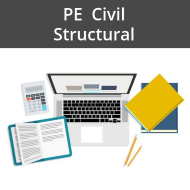Print Bundle: PE Civil Structural
Master Your PE Civil Structural Exam with Our Comprehensive Print Bundle
This comprehensive collection of resources was designed for thorough coverage of the PE Civil Structural exam. The review materials in this bundle cover the current exam specifications, contain thorough coverage of civil engineering principles and codes, and include numerous practice problems to challenge your knowledge of those concepts.
Products included in your bundle:
- PE Civil Structural Review Manual: Updated for the 2024 Exam. This up-to-date review book for the PE Civil Structural exam takes you step-by-step through every exam topic and subtopic. With useful study tips and examples throughout, this book will help you study efficiently and thoroughly for the exam. Topics covered include Analysis of Structures, Loads and Load Applications, Forces and Load Effects, Temporary Structures and Other Topics, Design and Details of Structures, Material and Material Properties, Component Design and Detailing, Concrete, Steel, Timber, Masonry, and Design Standards.
- PE Civil Structural Depth Six-Minute Problems: This book contains over 100 multiple-choice problems representative of the NCEES PE Civil Structural Exam format, scope of topics, and level of difficulty.
- Structural Depth Practice Exams for the PE Civil Exam: This book contains 80 practice exam questions representative of the NCEES PE Civil Structural Exam scope of topics and level of difficulty.
- Casio FX-115 ES Plus Advanced Scientific Calculator: Prepare for your exam with the versatile Casio FX-115 ES Plus calculator—accepted by the NCEES for all exams.
Referenced Codes and Standards
- AASHTO LRFD Bridge Design Specifications
- Building Code Requirements and Specifications for Masonry Structures and Companion Commentaries (TMS 402/602)
- Building Code Requirements for Structural Concrete and Commentary (ACI 318)
- International Building Code (IBC)
- CFR Title 29
- Minimum Design Loads for Buildings and Other Structures (ASCE 7)
- Wood Design Package (AWC NDS)
- PCI Design Handbook: Precast and Prestressed Concrete (PCI)
- Steel Construction Manual (AISC)
FAQs
Some states require a BS degree from an ABET-accredited engineering program to sit for the PE exam. Other states allow you to take the PE exam with a degree in engineering technology, physics, math, or chemistry—or without any degree—as long as you’ve met the required work experience. Check your state requirements to see if you can take the PE exam without an engineering degree.
Most states allow you to take the PE exam after passing your FE exam and gaining at least four years of post-college work experience. However, some states now allow examinees to sit for the PE exam before completing their work experience. Check your state requirements to see when you’re qualified to sit for the exam.
The PE exams are not considered easy to pass, but the exam will become easier if the content reflects topics that you're familiar with from your current line of work. Think about your career goals when considering the PE exam. Are you seeking a promotion in your current role? You should select the exam that best supports your current career. Are you trying to switch industries? Choose the exam that will set you up for success in your new field. Rather than seek out the easiest PE exam, select the one that will support your goals.
